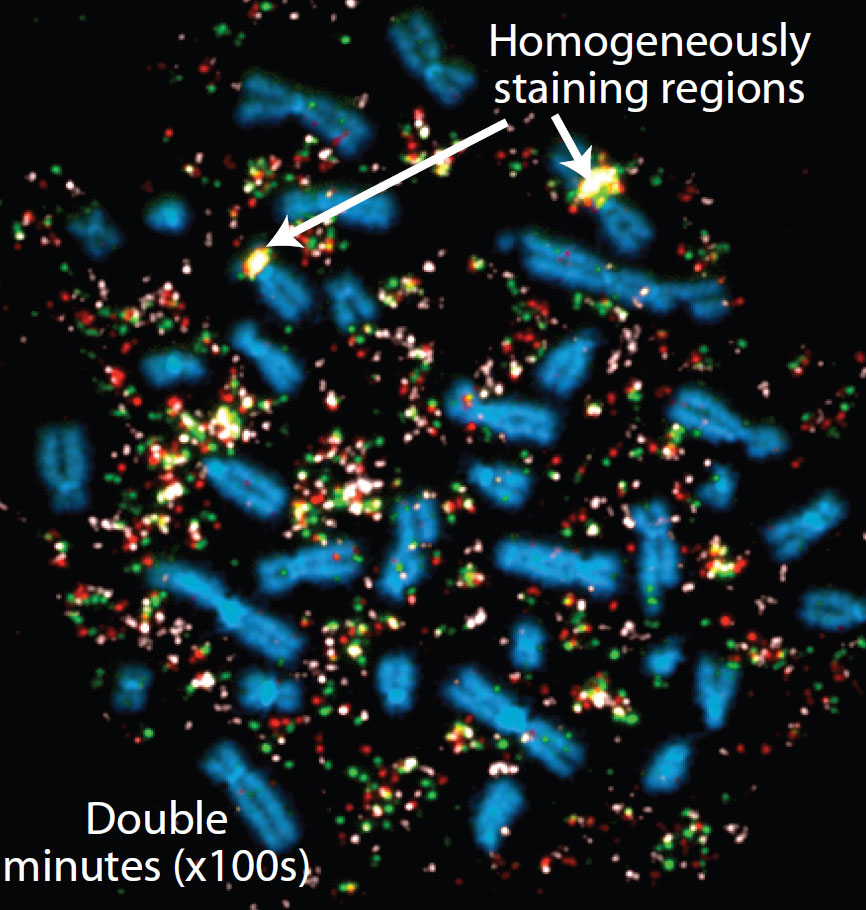Punctuated evolution in cancer genomes

Remarkable new research overthrows the conventional view that cancer always develops in a steady, stepwise progression. It shows that in some cancers, the genome can be shattered into hundreds of fragments in a single cellular catastrophe, wreaking mutation on a massive scale.
The scars of this chromosomal crisis are seen in cases from across all the common cancer types, accounting for at least one in forty of all cancers. The phenomenon is particularly common in bone cancers, where the distinctively ravaged genome is seen in up to one in four cases.
The team looked at structural changes in the genomes of cancer samples using advanced DNA sequencing technologies. In some cases, they found dramatic structural changes affecting highly localised regions of one or a handful of chromosomes that could not be explained using standard models of DNA damage.
“The results astounded us. It seems that in a single cell in a single event, one or more chromosomes basically explode – literally into hundreds of fragments.
“In some instances – the cancer cases – our DNA repair machinery tries to stick the chromosomes back together but gets it disastrously wrong. Out of the hundreds of mutations that result, several promote the development of cancer.”
Dr Peter Campbell from the Cancer Genome Project at the Wellcome Trust Sanger Institute and senior author on the paper
Cancer is typically viewed as a gradual evolution, taking years to accumulate the multiple mutations required to drive the cancer’s aggressive growth. Many cancers go through phases of abnormal tissue growth before eventually developing into malignant tumours.
The new results add an important new insight, a new process that must be included in our consideration of cancer genome biology. In some cancers, a chromosomal crisis can generate multiple cancer-causing mutations in a single event.
“We suspect catastrophes such as this might happen occasionally in the cells of our body. The cells have to make a decision – to repair or to give up the ghost.
“Most often, the cell gives up, but sometimes the repair machinery sticks bits of genome back together as best it can. This produces a fractured genome riddled with mutations which may well have taken a considerable leap along the road to cancer.”
Dr Andy Futreal Head of Cancer Genetics and Genomics at the Wellcome Trust Sanger Institute and an author on the paper
The new genome explosions caused 239 rearrangements on a single chromosome in one case of colorectal cancer.
The damage was particularly common in bone cancers, where it affected five of twenty samples. In one of these samples, the team found three cancer genes that they believe were mutated in a single event: all three are genes that normally suppress cancer development and when deleted or mutated can lead to increased cancer development.
“The evidence suggests that a single cellular crisis shatters a chromosome or chromosomes and that the DNA repair machinery pastes them back together in a highly erroneous order.
“It is remarkable that, not only can a cell survive this crisis, it can emerge with a genomic landscape that confers a selective advantage on the clone, promoting evolution towards cancer.”
Professor Mike Stratton Director of the Wellcome Trust Sanger Institute and an author on the paper
The team proposes two possible causes of the damage they see. First, they suggest it might occur during cell division when chromosomes are packed into a condensed form. Ionizing radiation can cause breaks like those seen. The second proposition is that attrition of telomeres – the specialized genome sequences at the tips of chromosomes – causes genome instability at cell division.
More information
Participating Centres
- Cancer Genome Project, Wellcome Trust Sanger Institute, Hinxton, Cambridge, UK
- Departments of Pathology & Oncology, Johns Hopkins Medical Institutions, Baltimore, Maryland, USA
- Department of Haematology, Addenbrooke’s Hospital, Cambridge, UK
- Department of Haematology, University of Cambridge, Cambridge, UK
- Cancer Institute, University College London, London, UK
- Royal National Orthopaedic Hospital, Middlesex, UK
- Institute for Cancer Research, Sutton, Surrey, UK
Funding
This work was supported by the Wellcome Trust and the Chordoma Foundation.
Publications:
Selected websites
The Wellcome Trust Sanger Institute
The Wellcome Trust Sanger Institute, which receives the majority of its funding from the Wellcome Trust, was founded in 1992. The Institute is responsible for the completion of the sequence of approximately one-third of the human genome as well as genomes of model organisms and more than 90 pathogen genomes. In October 2006, new funding was awarded by the Wellcome Trust to exploit the wealth of genome data now available to answer important questions about health and disease.
The Wellcome Trust
The Wellcome Trust is a global charitable foundation dedicated to achieving extraordinary improvements in human and animal health. We support the brightest minds in biomedical research and the medical humanities. Our breadth of support includes public engagement, education and the application of research to improve health. We are independent of both political and commercial interests.


